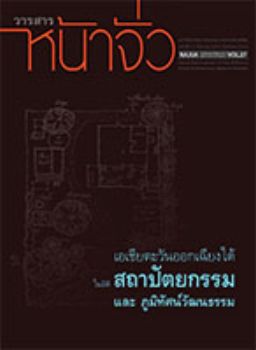ภูมิทัศน์วัฒนธรรม และพุทธศาสนสถาปัตยกรรมไทใหญ่แห่งหุบเขาแม่ฮ่องสอน: ศักยภาพต่อการเสนอขึ้นสู่บัญชีรายชื่อชั่วคราวเพื่อขอรับการพิจารณาเป็นแหล่งมรดกโลกทางภูมิทัศน์วัฒนธรรม
Keywords:
ภูมิทัศน์วัฒนธรรม, ภูมิทัศน์วัฒนธรรมแห่งหุบเขาแม่ฮ่องสอน, ไทใหญ่, ชาติพันธุ์กลุ่มน้อย, มรดกทางวัฒนธรรมในภาวะวิกฤติ, บัญชีรายชื่อชั่วคราว, มรดกโลก, Cultural Landscape, Cultural Landscape of Mae Hong Son Valley, Tai Yai Ethnic group, Minority PeopleAbstract
จังหวัดแม่ฮ่องสอนมีแหล่งมรดกทางวัฒนธรรมที่มีศักยภาพที่จะผลักดันเพื่อขอบรรจุรายชื่อเข้าสู่บัญชีรายชื่อชั่วคราว (Tentative List) ในหัวข้อ “ภูมิทัศน์วัฒนธรรมแห่งหุบเขาเมืองแม่ฮ่องสอน (Cultural Landscape of Mae Hong Son Valleys)” ซึ่งประกอบด้วยพื้นที่ 3 ส่วน คือ “ภูมิทัศน์วัฒนธรรมแห่งหุบเขาเมืองแม่ฮ่องสอน” “ภูมิทัศน์วัฒนธรรมหุบเขาเมืองเมืองปอน-ขุนยวม” และ “ภูมิทัศน์วัฒนธรรมหุบเขาเมืองแม่สะเรียง” ร่วมกันเพื่อนำไปสู่ข้อเสนอแนะในการขึ้นทะเบียนแหล่ง “มรดกโลกแบบรวมกลุ่ม (Serial Nomination on World Heritage List)” เนื่องจากประกอบด้วยแหล่งมากกว่า 2 แหล่งขึ้นไป และไม่ได้มีพื้นที่ทางกายภาพเชื่อมต่อกัน แตกต่างกันทางที่ตั้ง แต่มีความสัมพันธ์กันในประเด็นต่างๆ
นอกจากนี้ การศึกษายังพบว่า องค์ประกอบของภูมิทัศน์วัฒนธรรมแห่งหุบเขาแม่ฮ่องสอนที่กล่าวมาข้างต้นนั้นจะประกอบขึ้นจากองค์ประกอบหลัก 3 ประการ คือ “ภูมิทัศน์วัฒนธรรมหมู่บ้านไทใหญ่” “ภูมิทัศน์วัฒนธรรมพื้นที่การเกษตร” และ “ภูมิทัศน์วัฒนธรรมพุทธสถานวัดไทใหญ่” ซึ่ง 2 ประเด็นแรกถือว่าเป็นภูมิทัศน์วัฒนธรรมพื้นถิ่นซึ่งมีความสัมพันธ์วิถีชีวิตประจำวันของผู้คนอย่างใกล้ชิด ซึ่งก็ย่อมมีความเปลี่ยนแปลงอยู่ตลอดเวลาและรวดเร็ว เนื่องจากสัมพันธ์กับบริบททางสังคมและเศรษฐกิจ จึงเป็นเรื่องยากที่จะรักษารูปแบบภูมิทัศน์วัฒนธรรมดังกล่าวให้คงที่ไม่เปลี่ยนแปลงได้ ในสถานการณ์ในปัจจุบัน แต่อย่างไรก็ตามหากมีการสร้างความรับรู้ต่อชุมชนท้องถิ่นในประเด็นเรื่องคุณค่าในมิติต่างๆ รวมทั้งมีการค้นคว้าวิจัยอย่างมีส่วนร่วมระหว่างนักวิชาการ และชุมชนท้องถิ่นเพื่อแสวงหาทางออกสำหรับการพัฒนาคุณภาพชีวิต และขับเคลื่อนเศรษฐกิจของชุมชนให้เกิดความมั่งคั่ง แต่ต้องไม่ลดทอนคุณค่าของภูมิทัศน์วัฒนธรรมลง
สำหรับการดำเนินการขั้นต้นจึงควรเร่งดำเนินการศึกษาวิจัยเพื่อสร้างองค์ความรู้และการจัดทำแผนการบริหารจัดการ “ภูมิทัศน์วัฒนธรรมพุทธสถานวัดไทใหญ่” เป็นลำดับแรก เพื่อผลักดันให้ขึ้นทะเบียนบัญชีรายชื่อชั่วคราวเพื่อรอรับการพิจารณา โดยนำองค์ความรู้จากการวิจัยมาจัดทำฐานข้อมูลเพื่อและเอกสารประกอบ ตลอดจนเป็นข้อมูลสำหรับการจัดทำประกาศคุณค่าโดดเด่นอันเป็นสากล (Outstanding Universal Value) ต่อไป
ประโยชน์ที่คาดว่าจะได้รับของการดำเนินการผลักดันสู่การเป็นแหล่งมรดกโลกทางภูมิทัศน์วัฒนธรรมมีหลายมิติ อาทิเช่น การสร้างกระบวนทัศน์ใหม่ในการอนุรักษ์และพัฒนาแหล่งมรดกทางวัฒนธรรมอย่างยั่งยืน การส่งเสริมการท่องเที่ยวทางธรรมชาติ และวัฒนธรรมในฐานะของเศรษฐกิจสร้างสรรค์ และการสร้างมูลค่าเพิ่มจากทุนทางสังคม และวัฒนธรรม
นอกจากนี้ ยังเป็นการสร้างพลวัติของมรดกทางวัฒนธรรมไทใหญ่ทั้งที่เป็นมรดกทางวัฒนธรรมรูปธรรม (Tangible Cultural Heritage) และมรดกทางวัฒนธรรมนามธรรม (Intangible Heritage) ในภาวะการณ์ที่ชาวไทใหญ่ที่ตั้งถิ่นฐานในดินแดนต้นกำเนิดทั้งในเขตประเทศจีน และสหภาพเมียนมาร์กำลังตกอยู่ในสภาวะการณ์เป็นกลุ่มชาติพันธุ์ส่วนน้อย (Minority People) ที่กำลังตกอยู่ภายใต้ความเปลี่ยนแปลงจนกลายเป็นมรดกทางวัฒนธรรมที่อยู่ในภาวะวิกฤติ (Intangible Heritage at Risk) จึงเท่ากับว่าเป็นการสร้างความยั่งยืนต่อมรดกทางวัฒนธรรมอันหลากหลายของมวลมนุษยชาติไว้ทางหนึ่งอีกด้วย
Cultural landscape and Tai Yai Buddhist Monasteries in the Valley of Mae Hong son: Its Competency as a World Heritage Tentative List
Isarachai Buranaut
Researcher, Silpakorn University
Thapakorn Kruaraya
Researcher, lampang intertech college
Mae Hong Son Province possesses sites of cultural landscapes which are competent enough to be nominated as a World Heritage Tentative List. For the study of “Cultural Landscape of Mae Hong Son Valleys”, it comprises three main parts: Cultural Landscape of Mae Hong Son Valleys, Cultural Landscape of the town of Pon-Khun Yuam, and Cultural Landscape of the town of Mae Sariang. The cluster is aimed to be proposed as a serial nomination on World Heritage List due to their geographical factors which are not adjacent to one another along with differences but correlation can be found.
It was also found that the components of cultural landscape of Mae Hong Son valleys have been formed by cultural landscape of Tai Yai villages, cultural landscape of agricultural areas, and cultural landscape of Tai Yai temples. The cultural landscapes of Tai Yai villages and agricultural areas closely relate to local people’s ways of life, then changes come due to the fact about social and economic contexts. However, awareness, especially in terms of values, can be raised when studies among academic institutes and local communities work altogether so as to figure out means to develop life quality and economic aspects while cultural landscape values are not distorted.
The fundamental process is to study then bring about concrete knowledge into management plan, and ‘cultural landscapes of Tai Yai Monasteries” should be considered first. The study will prepare the database and documentation. This can lead to the nomination of World Heritage tentative list because of the outstanding universal value.
This study can be beneficial in terms of leading the site to World Heritage in many dimensions, for example the new understanding and realization in conservation and sustainable development of cultural heritage places, promotion of tourism in both natural and cultural aspects, as well as creation of creative economic aspects and added value from social and cultural components as budget.
In addition, the dynamic of Tai Yai’s cultural assets, both tangible and intangible heritage rooted in Myanmar and China, seem to be under changes as they have been considered minority. In other words, their cultural heritage, especially the intangible one, seems to be at risk. Hence, this study can lead to sustainability in cultural heritage of the human race.





